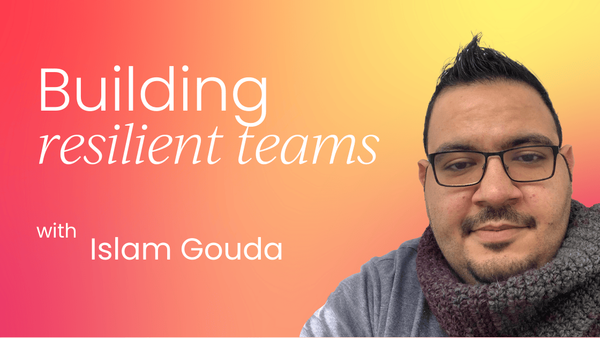In my years of leading marketing and corporate communication teams across diverse geographies, one lesson stands out: resilience is not simply about surviving disruption, but about adapting so seamlessly that disruption becomes an opportunity.
Resilient teams are not built overnight. They are the product of clarity in purpose, intentional culture-building, and the ability to translate ambiguity into direction.
Too often, companies misinterpret resilience as endurance – “pushing through the storm.” But real resilience is agility with foresight. It’s about anticipating shifts and empowering teams to pivot before the market forces them to.
The building blocks of team resilience
Shared purpose: When a team understands not just the “what” but the “why,” they unite around more than tasks – they align with meaning.
Cross-skilling: In times of disruption, the marketer who understands data analytics, or the engineer who grasps customer experience, becomes indispensable.
Psychological safety: Innovation cannot thrive in fear. The most resilient teams are those where speaking up is encouraged, and mistakes are framed as learnings.
In the West, particularly in U.S. companies, resilience often comes from structured contingency planning – playbooks for every scenario.
In the Middle East, I’ve observed resilience rooted in relationships, adaptability, and a deep cultural understanding of navigating uncertainty. Both approaches have merit, but the future will require a hybrid: a structure with fluidity.
Team management in the age of uncertainty
Managing teams amid industry shifts requires a new leadership playbook. Hierarchical command-and-control models fail under constant disruption; adaptive, empowering leadership is now the currency of resilience.
One revolutionary idea I advocate is dynamic leadership rotation within teams. Instead of one person always leading, leadership is distributed based on expertise and context.
For example, in a marketing team preparing for an AI-driven campaign, the data analyst may take the lead role temporarily, while in brand storytelling, the strategist leads. This empowers everyone to own leadership moments while reducing burnout from a single overburdened leader.
Resource management is equally critical. Teams often lose momentum when resources are misaligned – when the right tools, budgets, or talent are not in place at the right time.
Here, resilience means building redundancy into resources: overlapping skills, flexible budgets, and scalable technologies that allow quick reallocation.
Recommendations for CMOs and Leaders
Invest in skill adaptability: Training should not just prepare people for today’s tasks but prepare them to pivot.
Design flexible budgets: Avoid rigid annual marketing budgets. Instead, allocate “innovation buffers” to be used during disruption.
Use AI as augmentation, not replacement: Automating reporting or campaign optimization frees humans for creative, strategic thinking.
In industries like car rentals and travel, COVID-19 proved how fragile rigid systems can be. Those who survived were the ones who shifted resources quickly: car rental firms that pivoted to long-term leasing for remote workers, travel companies that rebranded as local experience curators.
The lesson here is that resource agility is not optional – it’s survival.
Resilience in global contexts: East meets West
Comparing how resilience plays out globally is fascinating. In China, resilience in organizations often stems from speed and scale. Teams are trained to move rapidly, iterate, and execute with discipline.
During market downturns, Chinese firms double down on agility, leveraging state support and collective drive to pivot entire business models within weeks.
In the U.S., resilience has historically been framed around innovation and risk-taking. Teams are encouraged to experiment boldly, fail fast, and reinvent. This creates a culture where resilience is embedded in the willingness to take risks rather than avoid them.
The Middle East, meanwhile, presents a unique case. Industries like fashion, hospitality, and even car rentals experience strong seasonality, driven by Ramadan, Eid, and holiday seasons. Teams here must plan resilience not just for global disruption but for predictable cultural cycles.
A fashion retailer in Dubai thrives when it can balance international fashion trends with local modest fashion requirements, pivoting its collections seasonally while maintaining global brand identity.
Examples of industries thriving through resilience
Travel and tourism: Emirates Airlines turned the crisis of 2020 into an opportunity by investing in customer trust, flexible bookings, and safety-first branding.
Fashion: Zara’s agile supply chain allowed it to adjust quickly during COVID and again during supply chain shortages, staying ahead of competitors.
Car rentals: Enterprise in the U.S. thrived by diversifying into ride-sharing partnerships and corporate fleets, while local Middle Eastern rental firms struggled with rigidity.
The global insight is clear: resilience is not one-size-fits-all. It is context-driven, shaped by culture, consumer patterns, and leadership styles.
Technology, AI, and the human element
We cannot discuss resilient teams without addressing AI. The temptation to over-reliance on AI is real.
I’ve witnessed organizations deploy chatbots, predictive analytics, and automated workflows, only to realize they stripped away the human touch that customers value most. Resilient teams use AI as a strategic ally – to scale, to inform, but never to replace.
The future playbook for resilient teams involves AI and human synergy. For example, in customer service, AI can filter simple queries, but complex, emotionally charged issues must go to empathetic human agents. In marketing, AI can predict campaign success, but human creativity still drives emotional resonance.
Leaders must prepare teams not only to use AI tools but to critically evaluate them. Blind reliance creates fragility; informed adoption builds resilience.
The human element that cannot be replaced
Emotional intelligence: Reading a client’s hesitation in a negotiation cannot be automated.
Cultural nuance: AI can analyze trends but struggles with cultural sensitivity in communication.
Visionary thinking: Predicting industry shifts requires human foresight, not just data points.
When I look at the future, I see resilient teams blending AI efficiency with human empathy, building organizations that are not just future-proof but future-ready.
The playbook for building resilient teams
To conclude, let me leave you with a novel playbook for building resilient teams amid industry changes:
- Anchor your team in a shared vision that transcends daily tasks.
- Empower different team members to lead in areas of their expertise.
- Ensure skills and budgets have overlap for flexibility.
- Learn from Eastern speed, Western innovation, and Middle Eastern adaptability.
- Use AI for efficiency, but never compromise the human element.
- Especially in B2C, design campaigns thrive on cultural and seasonal cycles.
- KPIs should track adaptability, learning speed, and team morale – not only revenue.
Resilient teams are not those that weather the storm untouched – they are the ones who transform through the storm.
In an era where change is the only constant, the true competitive advantage is not just innovation or efficiency, but the collective resilience of the teams driving your organization forward.
The companies that understand this – those who prioritize people, adaptability, and balanced technology adoption – will not only survive industry changes but will thrive because of them.






.png)









 Follow us on LinkedIn
Follow us on LinkedIn




